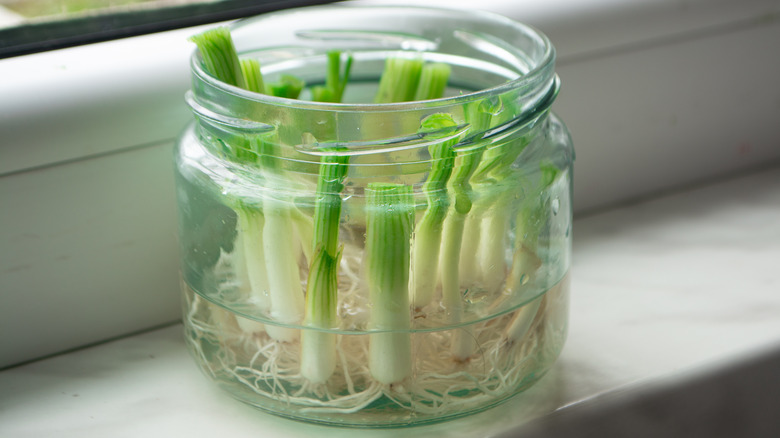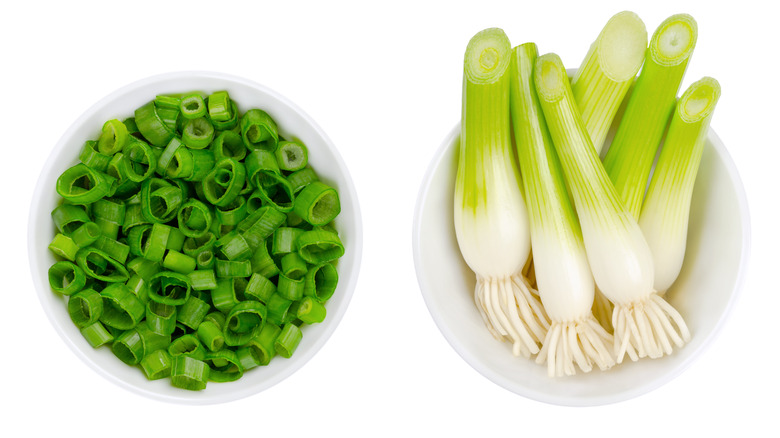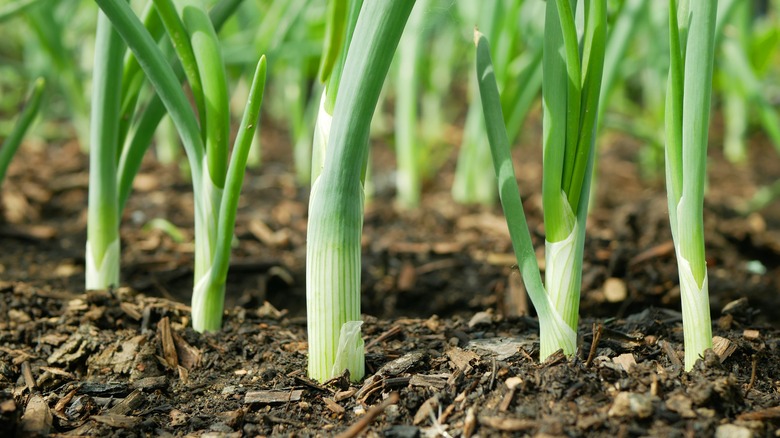The Real Difference Between Scallions And Green Onions
If you dice up scallions to put in your scrambled eggs, you might be a scallions fan. If you pluck a wild green onion from the earth and press it gently to your nose, savoring the fresh earthy smell, you might be a green onion fan. If you chop scallions to garnish your stir-fry while listening to the song "Green Onions" by Booker T. and The MG's — it's worship.
Scallions and green onions are both young onions that come from a particular type of Allium plant, the Allium fistulosum species. The name Allium is the Latin word for garlic, and the Allium genus includes more than a thousand species, including garlic, onions, leeks, ramps, chives, and shallots — all favorite types of onions. The white and green parts of green onions can both be used in cooking, although the darker green sections of the plant are usually used as garnish. If they weren't harvested during early stages of growth, scallions and green onions would grow into regular white, red, or yellow onions with massive bulbs.
As a card-carrying fan, home cooks and curious minds all over are dying to know: What's the difference between scallions and green onions? (Well, nobody's necessarily dying to know, but still.)
Compare the bulbs of scallions and green onions
There is very limited record of any evidence that scallions and green onions are, in fact, different — beyond perhaps their age and appearance.
According to Healthline, scallions are younger than green onions. They are the same plant, but with different names to refer to different ages. Healthline maintains that you can tell scallions apart from green onions by the width of the white bulb at the plant's base. The width of a scallion's bulb will be about the same width as the plant's stem and leaves.
Green onions, on the other hand, are a little older and have slightly larger white bulbs. The bulbs on fresh green onions are also slightly bulbous, as opposed to the round spherical bulbs on scallions.
Per The Washington Post, scallions and green onions are largely interchangeable in recipes, for both flavor and texture — which is convenient, since so much time in the kitchen is spent cooking with onions.
Scallions and green onions are the same species
Scallions and green onions are not separate species of onion. In fact, the professional chefs at MasterClass say there is no difference between green onions and scallions.
Scallions and green onions, they maintain, are the same thing, and both names can be used interchangeably to refer to the same plant. Specifically, they define this plant as any member of the Allium cepa species with stringy white roots and stiff white stalks less than ½-inch in diameter, that grow in bunches and are harvested young.
The Illinois Times echoes this idea, saying there is zero difference between scallions and green onions. The different names, it says, probably have more to do with a geographical dialectic difference. Whether they're called scallions or green onions begins and ends with vernacular. The paper says that in the mid-Atlantic coastal states and New England, you're more likely to find scallions in supermarkets. Everywhere else in the U.S., these vegetables are most often called green onions.
It's like Juliet's line to Romeo: "What's in a name? That which we call a rose by any other name would smell as sweet." No matter what you call 'em, a scallion is a green onion is a scallion. In all fairness, a bundle of scallions might not smell as good as a rose bouquet, but if you ask us that's only a matter of opinion. Just don't get us started on chives.


